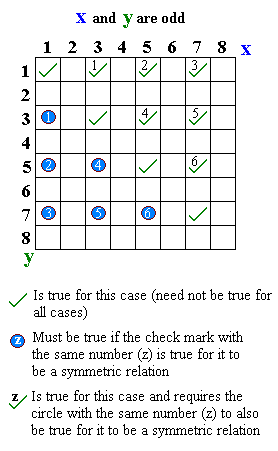Symmetric relation
A symmetric relation is a type of binary relation. Formally, a binary relation R over a set X is symmetric if:
where the notation aRb means that (a, b) ∈ R.
An example is the relation "is equal to", because if a = b is true then b = a is also true. If RT represents the converse of R, then R is symmetric if and only if R = RT.
Symmetry, along with reflexivity and transitivity, are the three defining properties of an equivalence relation.
Examples
In mathematics
- "is equal to" (equality) (whereas "is less than" is not symmetric)
- "is comparable to", for elements of a partially ordered set
- "... and ... are odd":
Outside mathematics
- "is married to" (in most legal systems)
- "is a fully biological sibling of"
- "is a homophone of"
- "is a co-worker of"
- "is a teammate of"
Relationship to asymmetric and antisymmetric relations

By definition, a nonempty relation cannot be both symmetric and asymmetric (where if a is related to b, then b cannot be related to a (in the same way)). However, a relation can be neither symmetric nor asymmetric, which is the case for "is less than or equal to" and "preys on").
Symmetric and antisymmetric (where the only way a can be related to b and b be related to a is if a = b) are actually independent of each other, as these examples show.
Properties
- A symmetric and transitive relation is always quasireflexive.
- One way to count the symmetric relations on n elements, that in their binary matrix representation the upper right triangle determines the relation fully, and it can be arbitrary given, thus there are as many symmetric relations as n × n binary upper triangle matrices, 2n(n+1)/2.
Note that S(n, k) refers to Stirling numbers of the second kind.
Notes
References
See also
- Commutative property – Property of some mathematical operations
- Symmetry in mathematics
- Symmetry – Mathematical invariance under transformations

